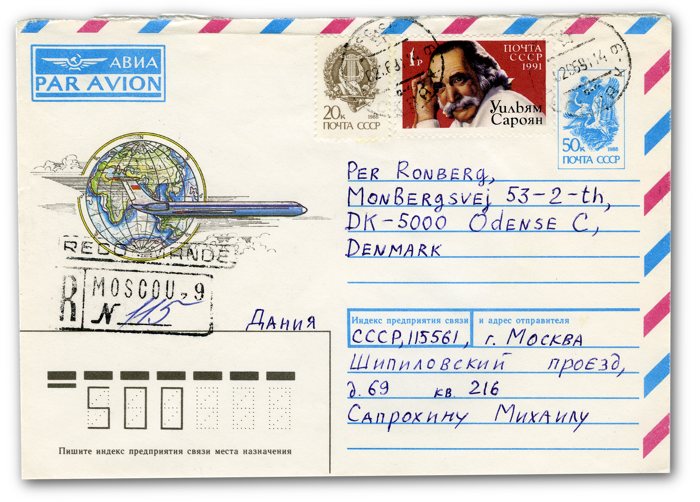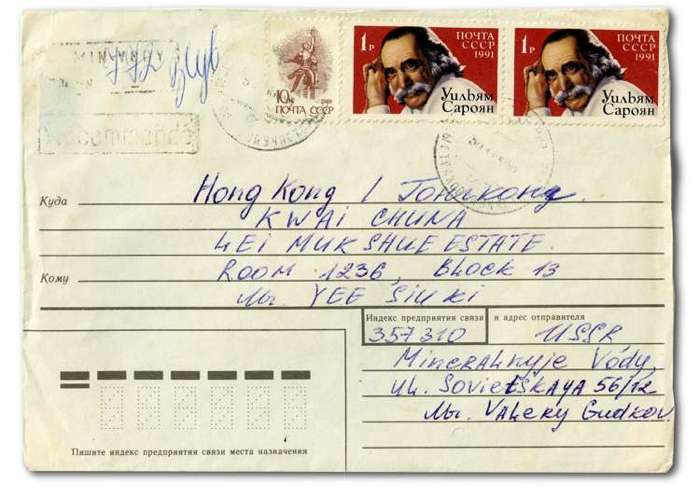William Saroyan posts a letter (Part 2)
The Armenian-American author and playwright William Saroyan, although he is not well known today, was nevertheless celebrated by the United States and the U.S.S.R. — the Soviet Union — in a joint stamp issue in 1991, 10 years after his death.
Question: Why did the U.S.S.R. commemorate William Saroyan with a stamp?
Answer: Saroyan was born in Fresno, California in 1908, but his parents were Armenian. In 1991, when the U.S.S.R. issued the Saroyan stamp, Armenia was the Republic of Armenia, one of the twelve original republics that made up the Soviet Union when it was created in December, 1922.


Is it rare? Yes, and no.
Non-collectors commonly ask this question about stamps they aren’t familiar with: Is it rare? The answer for both the Russian and the U.S. versions of the Saroyan stamp, as well as the Armenian stamp, is “Yes, and no.”
The U.S. Saroyan stamps can hardly be considered rare: almost 161.5 million copies of the stamp were printed. That’s one Saroyan stamp for every 1.6 Americans (the U.S. population in 1991 was almost 243 million).
Far fewer copies of the Russian Saroyan stamp were printed, only 900,000 in fact. That’s one for every 165 Russians; Russia’s population was slightly more than 148 million at the time the stamp was issued. Considering that Russia’s economy has not thrived in recent decades, it’s unlikely that Russians were lining up to buy them.1
The U.S. Saroyan stamps are readily available in mint condition and in used condition on a variety of first-day covers, maximum cards, and souvenir sheets.

Armenia declared independence from the U.S.S.R. in 1990, becoming the first non-Baltic republic to secede from the Soviet Union. In 2008, Armenia issued a stamp celebrating the centenary of William Saroyan’s birth. In an extensive search on the internet, I have found just two of the Armenian stamps offered for sale, a single mint copy and a maximum card.2 The paucity of Armenian Saroyan stamps possibly reflects a very small issue of stamps, and very likely the low demand for those stamps.
If mint copies of the U.S. and Russian Saroyan stamps aren’t rare, there are two types of Saroyan collectibles that are hard to find, if not exactly rare: postally used stamps and postally used covers.3
Most people who have ever mailed a letter used ordinary definitive stamps, those small stamps that commonly feature a portraits of famous people — presidents, prime ministers, kings, and queens — or national symbols such as a flags or coat of arms. That’s partly because postal administrations do a poor job of advertising new commemorative or pictorial stamps, or because postal clerks didn’t offer them. Often, postal outlets aren’t even supplied with new stamp issues. There is the issue of practicality as well: small stamps are easier to affix than large stamps. As a result, it can be virtually impossible to find commemorative or pictorial stamps that have actually done their duty in the mail stream.
In the case of the Saroyan stamp, few of the Russian or U.S. issues seem to have been used by postal patrons. As of the writing of this web page, not a single major stamp dealer was offering even one postally used cover franked with a Saroyan stamp or stamp. I have only two postally used covers in my collection, both from Russia, which in theory at least should be much harder to obtain than covers franked with the U.S. Saroyan stamp.


The Saroyan stamps’ designer, Ren Wicks
The Saroyan stamps were designed by Los Angeles artist Ren Wicks (1911-1997?). Wicks was an all-around artist best known for his paintings of aircraft for ad campaigns and pilot handbooks, and for his pinup art. Howard Hughes hired him create posters for RKO, most memorably one of Jane Russell for RKO in The Outlaw. He painted illustrations for Esquire, Redbook, Saturday Evening Post, Collier’s,” and Coronet, and ads for Kotex, Edwards Coffee, and swimwear companies.

Wicks’ William Saroyan stamp was in production for more than a year. It was a joint issue between the United States and the Soviet Union, and the first joint issue of the two superpowers to feature a person. In a 1991 Los Angeles Times interview, he said, “The Soviets doctored my artwork to make their version more ethnic — more brooding and Middle Eastern.”
“…the people on the committee aren’t trained artists”
Wicks submitted four designs to the Stamp Advisory Committee, a prestigious body of private citizens who select each year’s stamp issues. “I would have chosen another, more dramatic one,” Wicks said. “But they liked this one. That’s why you get so many mediocre-looking stamps—the people on the committee aren’t trained artists.” (In their defence, the committee does have an easy time, fielding between 15,000 and 20,000 suggestions annually.
Of the Soviet stamp Wicks said, “This is a little cute, a little contrived. I would have liked him more Olympian, more heroic.”
Wicks never thought of himself as a stamp artist: “It’s not something you apply for. It’s a caprice of fate,” he said. “You’re in there, or you’re not.” Wicks’ first commission was 1974’s 10-cent crossed flags stamps, commemorating the nation’s bicentennial. Despite the limitations of stamp art, which pays nominally, Wicks said in the interview that he “…relishes the opportunity “to contribute to the culture. Designing stamps is an honor; my work will be perpetuated forever.”

-
While postal administrations these days issue scores of new commemorative and pictorial stamps, relatively few are ever used as postage, but are primarily intended to be purchased and saved in mint condition by stamp collectors. How else to explain why so few are actually used as postage? In 1991, the year that the U.S. issued the Saroyan commemorative stamp, the U.S. Postal Service released 71 new, face-different stamps, including definitive stamps for regular use over the next few years, and commemorative and pictorial stamps to be sold until supplies ran out. With print runs into the hundreds of millions of stamps, the cost-per-stamp must be a fraction of a cent. There can’t be many commodities — not even women’s lingerie! — sold at such a high mark-up. ↩︎
-
In philately, a maximum card (also known as a maxi-card, or maxicard) is a postcard with a postage stamp placed on the picture side of the card where the design of the stamp and postcard match or are in concordance. In most cases, the cancellation is also related to the image on the front of the card and the stamp. When a postcard, stamp, and postmark that fit together, they are said to be in maximum concordance. That is where the name maximum card comes from. The collecting of maximum cards, more popular in Europe than in North America, is known as maximaphily. ↩︎
-
Postal history collectors (stamp collectors who specialize in used envelopes, which they call “covers”) search for covers which we describe as being “postally used”. That means that the sender’s primary interest was to mail the particular item that the cover enclosed. The stamps that frank the cover are of little interest to the person mailing it.
Postal historians generally ignore covers that are “philatelic,” which means that the purpose of the sender was to create a philatelic collectible that would be carried in the mail stream. It is not uncommon for collectors to mail covers to themselves in order to obtain a postally used cover bearing particular stamps. ↩︎